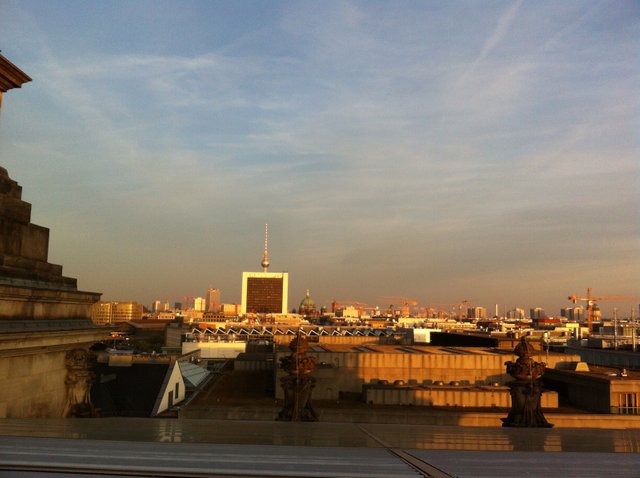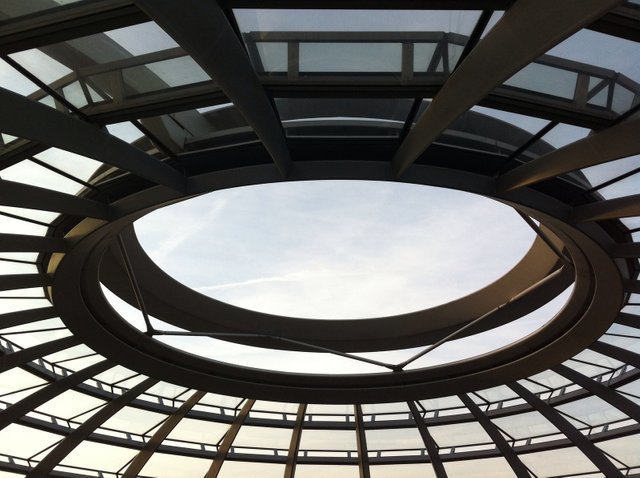La cúpula del Reichstag/The dome of the Reichstag for Monomad Challenge
La cúpula del Reichstag

El edificio del Reichstag, en Berlín, es donde se reúne el parlamento alemán (Bundestag).
Cuando terminó la guerra mundial la Segunda Guerra Mundial el Reichstag había sufrido unos violentos combates y estaba prácticamente destruido
Después de varias reformas del edificio y tras la unificación alemana se decidió que el Bundestag se ubicara en Berlín
Para la actual modernización se hizo un concurso público al que se presentaron 80 proyectos, quedando tres finalistas. Entre la selección ultima estaba el arquitecto británico Norman Foster y el español Santiago Calatrava.
El concurso lo ganó Norman Foster con un proyecto que no terminó de gustar a la ciudadanía y que tuvo que ser modificado por la presión política y social. Como consecuencia de las demandas, se le incorporó una cúpula transparente. Santiago Calatrava lo acusó de plagio, ya que en el proyecto original de Foster la cúpula no existía, mientras que era patente en el proyecto del valenciano.
La cúpula que se añadió finalmente ha sido un rotundo éxito. Se ha convertido en una visita indispensable y turística de primer nivel, así como en un símbolo de Berlin. Diariamente la recorren 8000 personas.
Para llegar a la cúpula hay que subir a una terraza que está a 24 m de altura y sobre ella se encuentra la estructura de cristal y acero.
La cúpula tiene un diámetro de 40 metros, una altura de 23,5 metros y un peso 800 toneladas. La remodelación diseñada por Norman Foster costó 600 millones de marcos, estrictamente lo que se había pactado. De igual forma, con matemático rigor, la renovación se hizo en cuatro años como figuraba en el contrato. Se inauguró el 19 de abril de 1999.



Evidentemente, no nos podíamos perder esta visita. Cuando llegamos al interior de la cúpula observamos que había dos rampas, una que subía y otra que bajaba, dispuestas ambas en extremos opuestos.
Por su interior, siguiendo la rampa ascendente y en espiral, pudimos admirar unas magníficas vistas de Berlín. Estaba atardeciendo y los colores del cielo eran cálidos. Unos auriculares audioguía que nos entregaron nos fueron explicando, mientras avanzábamos, los edificios visibles desde esta vista panorámica. Por algún sistema que nos localizaba, cuando llegábamos a un punto determinado, se escuchaba una grabación explicativa.
En la parte central hay una torre recubierta de espejos. Los alemanes tienen una gran concienciación ecológica, admirable de todo punto. La orientación de los espejos de la torre central, permite una iluminación cenital natural de la sala de plenos del parlamento, totalmente ecológica y muy económica.
Me pasé un buen rato haciendo fotografías jugando con la composición y orientación de estos espejos, intentaba fotografiar mi reflejo, pero no lo conseguí.





The dome of the Reichstag
The Reichstag building in Berlin is where the German parliament (Bundestag) meets.
When the World War ended the Second World War the Reichstag had suffered violent fighting and was practically destroyed
After several reforms of the building and after German unification it was decided that the Bundestag be located in Berlin
For the current modernization, a public contest was held to which 80 projects were submitted, with three finalists remaining. Between the last selection was the British architect Norman Foster and the Spanish Santiago Calatrava.
The contest was won by Norman Foster with a project that did not end up liking the citizenship and that had to be modified by political and social pressure. As a result of the demands, a transparent dome was incorporated. Santiago Calatrava accused him of plagiarism, since in the original project of Foster the dome did not exist, while it was patent in the Valencian project.
The dome that was added has finally been a resounding success. It has become an essential touristic and first-class visit, as well as a symbol of Berlin. 8000 people go through it daily.
To reach the dome you have to climb a terrace that is 24 m high and above it is the structure of glass and steel.
The dome has a diameter of 40 meters, a height of 23.5 meters and a weight of 800 tons. The remodeling designed by Norman Foster cost 600 million marks, strictly what had been agreed. Similarly, with mathematical rigor, the renewal was made in four years as it appeared in the contract. It was inaugurated on April 19, 1999.
Obviously, we could not miss this visit. When we reached the interior of the dome we observed that there were two ramps, one that went up and another that went down, both arranged at opposite ends.
Through its interior, following the ascending and spiral ramp, we could admire magnificent views of Berlin. It was getting dark and the colors of the sky were warm. Some audioguide headphones that they gave us were explaining to us, while we were advancing, the buildings visible from this panoramic view. By some system that located us, when we reached a certain point, we listened to an explanatory recording.
In the central part there is a tower covered with mirrors. The Germans have a great ecological awareness, admirable of all points. The orientation of the mirrors of the central tower, allows a natural zenith lighting of the plenary hall of the parliament, totally ecological and very economical.
I spent a lot of time taking photographs playing with the composition and orientation of these mirrors, I tried to photograph my reflection, but I did not get it.

This picture is my participation in the Monomad contest created by @brumest and made in his account @monochromes in Steemit and WEKU. If you want to participate, the rules are simple!
Meet Monomad Challenge


Original design for @talentclub de @carlos-cabeza
Espero sinceramente que os haya gustado esta publicación. Espero contar contigo en otras experiencias.y deseo que este arcoíris nos traiga a todos esas buenas noticias que tanto ansiamos.
I sincerely hope that you liked this publication. I hope to count on you in other experiences. And I hope that this rainbow will bring us all that good news that we crave so much.


Todas las fotos son mías y originales. Las hice con mi iPhone 6. Además, soy el autor de los dibujos de separadores.
¡Espero tus comentarios!
All the photos are original and mine. I made with my iPhone 6. Also, I'm the author of the separator drawings.
I await your comments!
¡Buen Camino!
Congratulations @volcandemorcilla! You have completed the following achievement on the Steem blockchain and have been rewarded with new badge(s) :
Click here to view your Board of Honor
If you no longer want to receive notifications, reply to this comment with the word
STOPTo support your work, I also upvoted your post!
Muchísimas Gracias
Buenas tomas como siempre!! :D